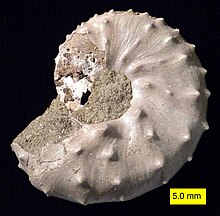| Discoscaphites | |
|---|---|

| |
| Discoscaphites iris, Owl Creek Formation (Upper Cretaceous), Ripley, Mississippi. | |
| Scientific classification | |
| Domain: | Eukaryota |
| Kingdom: | Animalia |
| Phylum: | Mollusca |
| Class: | Cephalopoda |
| Subclass: | †Ammonoidea |
| Order: | †Ammonitida |
| Suborder: | †Ancyloceratina |
| Family: | †Scaphitidae |
| Subfamily: | †Scaphitinae |
| Genus: | †Discoscaphites Meek, 1870 |
| Species[1] | |
| |
Discoscaphites is an extinct genus of ammonite. This genus may have been one of the few to have briefly survived the K-Pg mass extinction.
Distributions
[edit]Cretaceous of Greenland, Alabama, Arkansas, California, Colorado, Kansas, Maryland, Mississippi, Missouri, New Jersey, South Dakota, Tennessee, Texas, Wyoming,[1] and North Carolina.[2] Discoscaphites is present in the famous Pinna Layer of the Tinton Formation of New Jersey (above the iridium anomaly), with even possible records in the layer above, along with Eubaculites.[3] Some researchers prefer a conservative interpretation when dating the Pinna Layer, the other remains still suggest Discoscaphites was a K-Pg survivor, albeit restricted to 65 Ma.[4]
References
[edit]- ^ a b "Paleobiology Database - Discoscaphites". Retrieved 17 December 2021.
- ^ Chandler and Timmerman, Richard and John (2014). Fossil Mollusks - Volume II of IV. North Carolina: North Carolina Fossil Club. p. 20. Archived from the original on 2016-03-15. Retrieved 2016-05-16.
- ^ Landman, Neil H.; Garb, Matthew P.; Rovelli, Remy; Ebel, Denton S.; Edwards, Lucy E. (December 2012). "Short-Term Survival of Ammonites in New Jersey After the End-Cretaceous Bolide Impact". Acta Palaeontologica Polonica. 57 (4): 703–715. doi:10.4202/app.2011.0068. ISSN 0567-7920. S2CID 55646492.
- ^ Landman, Neil H.; Goolaerts, Stijn; Jagt, John W.M.; Jagt-Yazykova, Elena A.; Machalski, Marcin (2015), Klug, Christian; Korn, Dieter; De Baets, Kenneth; Kruta, Isabelle (eds.), "Ammonites on the Brink of Extinction: Diversity, Abundance, and Ecology of the Order Ammonoidea at the Cretaceous/Paleogene (K/Pg) Boundary", Ammonoid Paleobiology: From macroevolution to paleogeography, vol. 44, Dordrecht: Springer Netherlands, pp. 497–553, doi:10.1007/978-94-017-9633-0_19, ISBN 978-94-017-9632-3, retrieved 2021-10-27
External links
[edit]- "Spectacularly Blood Red Discoscaphites Fox Hills Ammonite". The Virtual Fossil Museum. Retrieved 2009-02-02.
Well, that’s interesting to know that Psilotum nudum are known as whisk ferns. Psilotum nudum is the commoner species of the two. While the P. flaccidum is a rare species and is found in the tropical islands. Both the species are usually epiphytic in habit and grow upon tree ferns. These species may also be terrestrial and grow in humus or in the crevices of the rocks.
View the detailed Guide of Psilotum nudum: Detailed Study Of Psilotum Nudum (Whisk Fern), Classification, Anatomy, Reproduction